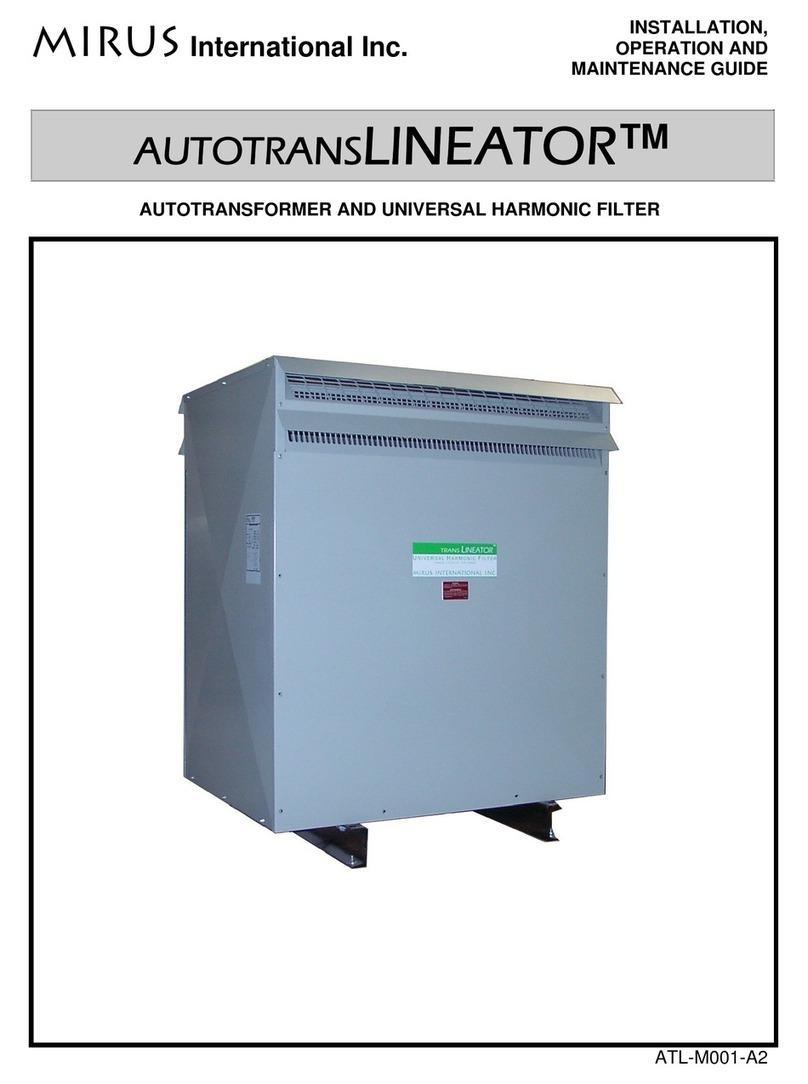
Operation & Maintenance Manual
3.1 Location
Location of the Lineator™ should be made with
consideration given to accessibility, ventilation and
atmospheric conditions. Installation locations
should be free of contaminants including dust,
fertilizer, excessive moisture, corrosive gases,
flammable materials or chemical fumes. Filtered
air may be considered to reduce maintenance
where air born contaminants are a problem.
Sufficient clearances from walls and other
obstructions should be provided to permit
unrestricted opening of hinged and removable
doors, covers and panels for the purpose of wiring
terminations, inspection, maintenance and testing.
Also, proper ventilation requires at least 6 in.
(155mm) clearance at all ventilation openings,
with the exception of the rear face of wall
mountable enclosures such as the SU1, SU2, SU3
and SU4 type enclosures. Ambient temperature
must not exceed 104 Deg F (40 Deg C). In
enclosed rooms, minimum air circulation of 100 ft3/
min per kilowatt of loss should be provided.
Do not stack Lineators or install above other
heat source equipment.
Enclosures are designed in accordance with
NEMA and UL standards and can allow for
installation in various environments. Standard
enclosures for the Lineator™ are NEMA3R rated.
For derating factors which apply to installations
above 3000ft [1000m] refer to Section 7.5 Lineator
Type Operational Curve.
3.2 Inspection and Energization
Upon receipt of shipment, the Lineator™ should
be inspected for any damage incurred during
shipment. Before energization an internal
inspection should be conducted with emphasis on
loose or broken connections, damaged or
displaced parts, cracked insulators, dirt or foreign
material, or evidence of moisture. While servicing
the Lineator, all relevant safety standards must be
followed, including all applicable electrical codes
and NFPA 70E – Standard for Electrical Safety in
the Workplace.
3.2.1 Before Energization
•Verify that the Lineator external feeder
circuit breaker is in the OFF/OPEN
position so that unit is de-energized.
•Check all bolts, nuts, screws, and
connections for tightness and inspect for
broken or damaged components or
cables.
•Clean, vacuum, and clear interior of
Lineator enclosure of any extra hardware
and debris.
•Verify proper three-phase wiring of system
power wires, ground, and feeder breaker.
•Check all capacitors for swelling, leaking,
or extruded vents; replace if necessary.
Verify all fuses for integrity and rating.
•If Lineator has been sitting idle for 6
months or longer before first energization,
it is recommended that the maintenance
procedure described in 5.0 is performed
prior to startup.
3.2.2 Initial Lineator start-up and run
•If test measurements are to be taken,
connect any test equipment before
energization.
•It is recommended that any test
instruments be connected such that all
enclosure panels can be installed properly
and Lineator can be fully enclosed.
Consider using meters with remote
wireless displays if possible.
•When energizing, use appropriate
personal protection equipment (PPE) and
other precautions as required by NFPA
70E.
3.3 Handling
The Lineator™ should be thoroughly protected
against the entrance of dust, rain or snow when
handled outdoors.
When lifting the Lineator™, the lifting cables
should be held apart by a spreader to avoid
bending the lifting lugs or other parts of the
structure. To access the lifting lugs, remove the
top enclosure cover. The Lineator™ may be
skidded or moved on rollers but care must be
taken not to damage the base or tip it over. When
rollers are used under larger units, skids must be
used to distribute the stress over the base.
After the Lineator™ is placed in permanent
position, shipping braces should be removed and
shipping bolts, if present, should be loosened.
Where isolation pads have been included, the
bolt should be loosened until the spring
washer has been relaxed before putting into
service. This will reduce noise resulting from the
Lineator’s™ natural vibration.





























